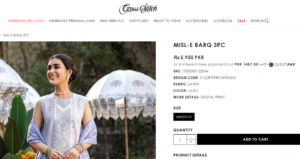KARACHI: If there is one thing that Pakistani women are blamed for doing, it is that we spend most of our money on clothes. With few alternatives present for public entertainment, our people tend to turn to shopping for leisure. But where do we draw the line between leisure and obsession? How do we get ourselves out of the shackles of capitalism? What role do clothing brands play in all of this?
Our brands are big on fast fashion. From ready-to-wear pieces to unstitched collections and even customized articles, we want to put a price tag on everything. Not too long ago, brands like Sapphire and Cross Stitch, amongst others, introduced the option to buy clothes in instalments.

This was made possible in collaboration with Qisst Pay, a platform that allows you to buy from certain brands in instalments. The idea may seem rational for products like electrical appliances. But why do we need to be buying clothes in instalments? Clothes that are most definitely not a one-time purchase.

Isn’t the point of instalments allowing people to invest in assets that last them in the long-run? When someone buys a car in instalments, they are investing in a vehicle that will last them a good 10 years. They probably buy the car to be used by the whole family. Unlike clothes. That will only benefit one person. Until they buy another dress, probably the very next week.
By allowing consumers to buy clothes in instalments, aren’t local brands further encouraging people to spend more? On things that they don’t need and things that will probably not last them more than a few months. Who is the target audience for these campaigns anyway? Through their collaboration with Qisst Pay, brands are able to sell a Rs.1500 dress on instalments and do the same to an outfit that costs Rs.50,000. What kind of spending are we encouraging?
In a country where inferiority complex is very much present and what one wears is almost a competition, are such platforms not encouraging people to spend more than what they can afford? A woman from a lower socioeconomic class may not be able to afford a dress that costs Rs.2000 today, but she can afford to pay Rs.500 right now. Through four monthly instalments, she could get the dress today and keep investing Rs.500 each month. Are brands really looking out for this woman then? Are they really helping her make conscious decisions and budget her income in a more disciplined manner? Or are they simply fishing on her desire to fit in?
What about sustainable fashion then? A narrative that most major brands seem to be fond of. Only last year, Sapphire introduced its Revive the Thread campaign. Donate five clothes, get a 10% discount on the brand’s sustainable collection. And then spend some more money buying the other collection in monthly instalments. How sustainable really are these brands? What narrative are we feeding the consumers then?
View this post on Instagram
With options like monthly payments, are brands really helping consumers manage their finances and make more conscious choices? Or will they simply end up spending more than what they can afford in the first place? Who benefits from all of this? When does this end?

 Artwork by Aamir Khan
Artwork by Aamir Khan











